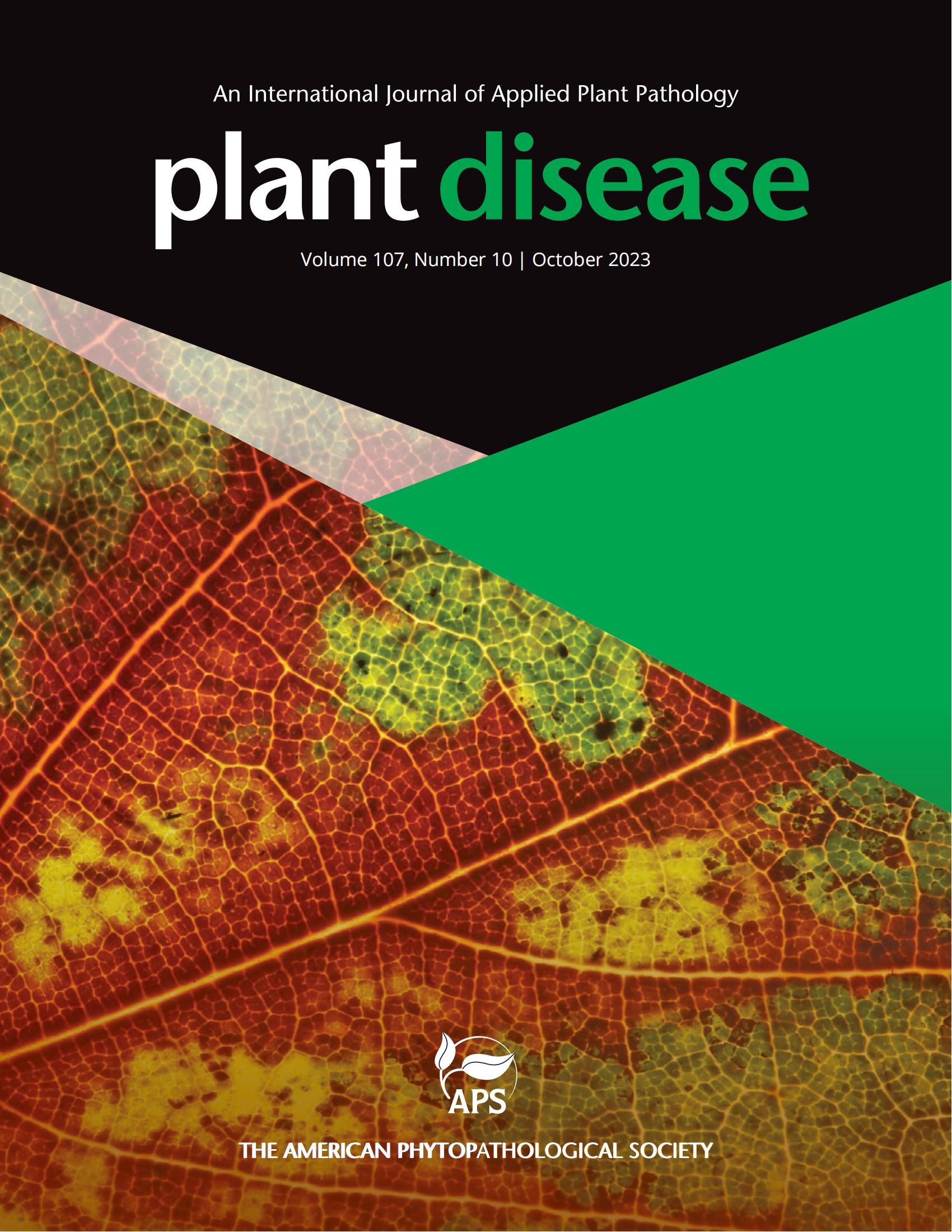枯黄乳杆菌致细菌性萎蔫病初报。烟草上的黄萎病。
摘要
烟草(Nicotiana tabacum)是一种重要的经济作物,在全球范围内具有多方面的影响。2024年7月,在中国贵州安顺一处烟草田(106°05′7.1″E, 26°03′9.9″N),观察到云烟87出现类似烟草青枯病的萎蔫症状。受感染的植株最初在茎基部出现褪绿斑点,随后是叶或茎的枯萎,维管束变褐,有时甚至死亡。病害发病率约40%,造成产量损失20%以上。疾病样本在室温下进行了一夜的保湿处理。从切除的茎中获得的培养汁液用灭菌水稀释,并涂在LB琼脂板上。28°C孵育2天后,从平板上挑选出浅黄色、圆形、光滑的菌落,用参考引物进行菌落PCR扩增(gonalves et al., 2019;Osdaghi et al., 2024;Weisburg et al., 1991)。3株分离株(14-28-27、14-15-19和15-11-17)的16S rDNA序列数据(GenBank accession号:PV104305 ~ PV104307)与faccumfaciens Curtobacterium型菌株C-S-R1-2 (GenBank accession号:GenBank)具有100%的相似性。MK398100)基于BLASTn搜索。基于recA、gyrB、atpD、ppk和rpoB基因,利用MEGA-X 10.1.6版本构建系统发育树(Kumar et al, 2018),结果表明,这3株分离株属于flacfaciens pv。flaccumfaciens (Cfpf)。5个基因的部分序列提交至GenBank,登录号为PV259359 ~ PV259373。采用高8.7 cm、上径9.7 cm、下径6.7 cm的塑料花盆,对55日龄烟草植株进行致病性试验。植物按照描述接种(Urrea, et al., 2014)。用灭菌水处理的植物作为对照。将接种后的幼苗移送至29±1℃、湿度≥60%的温室。接种10 d后,接种植株下部叶片枯萎,木质部变色。对照组没有出现任何症状。进行了三次致病性试验,结果一致。通过菌落形态和recA、gyrB、atpD、ppk和rpoB基因的多位点序列分析,这些细菌被鉴定为Cfpf,符合Koch的假设。Cfpf是一种常见的植物病原体,可引起铁皮石斛和菜豆的细菌性病害(Wang et al., 2016;Osdaghi et al., 2020)。据我们所知,这是Cfpf引起烟草细菌性枯萎病的第一份报告。该报告拓宽了Cfpf的宿主范围,并强调了该细菌作为植物病原体的重要性。Tobacco (Nicotiana tabacum) is an economically important crop, possessing a multifaceted impact on a global scale. In July 2024, wilting symptoms resembling tobacco bacterial wilt were observed on the cultivar Yunyan87 in a tobacco field (106°05'7.1″E, 26°03'9.9″N), Anshun, Guizhou, China. The infected plants initially presented chlorotic spots on the basal part of the stem, followed by wilting of leaves or stems, vascular browning, and in some cases, even death. Disease incidence is about 40%, causing yield losses over 20%. The disease samples were subjected to a moisturizing treatment overnight at room temperature. Cultured sap obtained from excised stems was diluted with sterilized water and plated onto LB agar plates. Post-incubation at 28°C for 2 days, the buff, circular, smooth colonies were picked from the plates and amplified using colony PCR with reference primers (Gonçalves et al., 2019; Osdaghi et al., 2024; Weisburg et al., 1991). The 16S rDNA sequence data (GenBank accessions PV104305 to PV104307) of three isolates (14-28-27, 14-15-19, and 15-11-17) shared 100% similarity with that of Curtobacterium faccumfaciens type strain C-S-R1-2 (GenBank accession no. MK398100) based on BLASTn search. The phylogenetic tree constructed using MEGA-X version 10.1.6 (Kumar et al., 2018) based on the recA, gyrB, atpD, ppk, and rpoB genes demonstrated that the three isolates belong to C. flaccumfaciens pv. flaccumfaciens (Cfpf). The partial sequences of the five genes were submitted to GenBank with accession numbers PV259359 to PV259373. Pathogenicity test was conducted on 55-day-old tobacco plants grown in plastic pots (8.7 cm height, 9.7 cm upper diameter, and 6.7 cm bottom diameter). Plants were inoculated as described (Urrea, et al., 2014). The plants treated with sterilized water acted as a control. The inoculated seedlings were moved to the greenhouse at 29 ± 1°C and ≥ 60% humidity. Ten days after inoculation, wilting of lower leaves and xylem discoloration were observed in inoculated plants. No symptoms appeared in the controls. Pathogenicity tests were performed three times with consistent results. The bacteria were reisolated from the inoculated plants and identified as Cfpf through colony morphology and multilocus sequence analysis of the recA, gyrB, atpD, ppk, and rpoB genes, fulfilling Koch's postulates. Cfpf, a common plant pathogen, causes the bacterial disease in Dendrobium officinale and Phaseolus vulgaris (Wang et al., 2016; Osdaghi et al., 2020). To our knowledge, this is the first report of Cfpf causing bacterial wilt in tobacco. This report broadens the host range of Cfpf and underscores the significance of this bacterium as a plant pathogen.

 求助内容:
求助内容: 应助结果提醒方式:
应助结果提醒方式:


